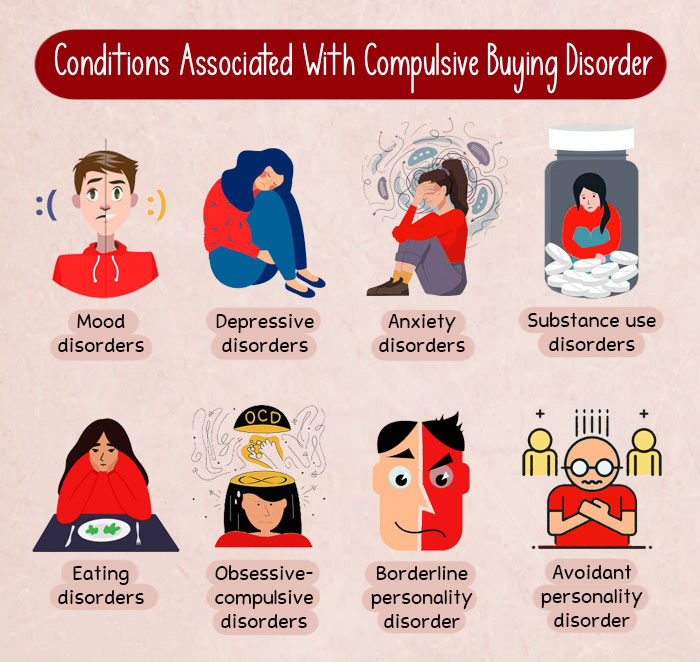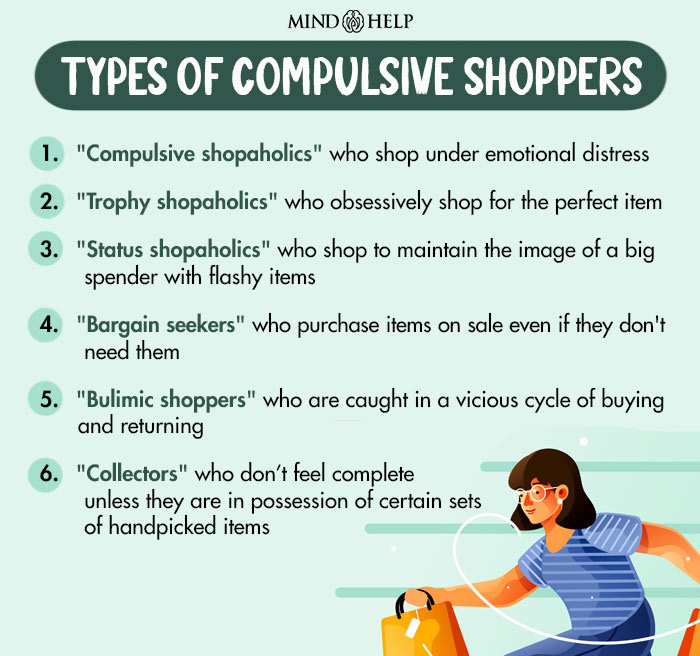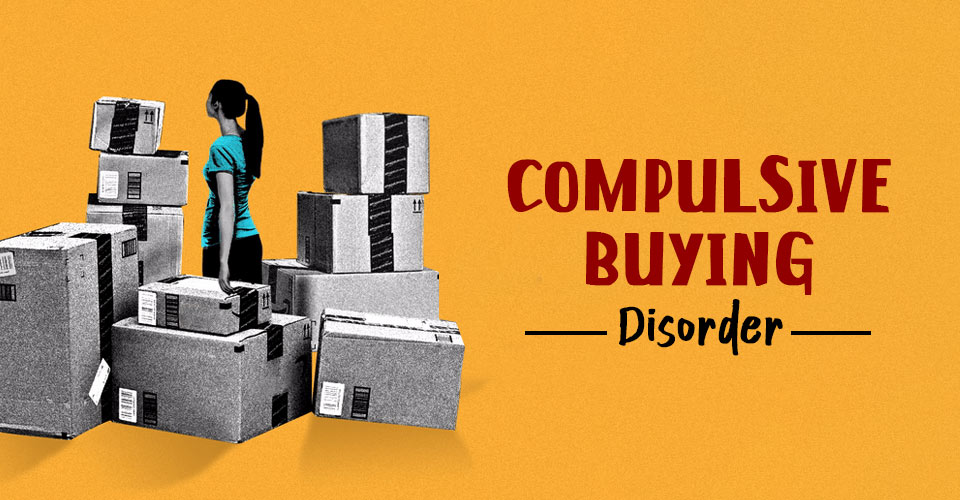Ever feel like you just have to buy something, even when you don’t need it? That urge might be more than just impulse, it could be Compulsive Buying Disorder (CBD). Also called shopping addiction or shopaholism, this condition involves a constant need to shop that can lead to serious consequences.
What Is Compulsive Buying Disorder?
Compulsive buying disorder (CBD) is a mental health condition in which a person experiences the persistent, frequent, and uncontrollable urge to purchase material possessions. It is also known as “oniomania” (from Greek “ṓnios” meaning “for sale” and “manía” meaning “insanity”).
Mental health experts often describe compulsive buying disorder in different ways. Some see it as an impulse control issue, others link it to obsessive-compulsive behavior or even personality disorders. In some cases, it’s also labeled a money disorder or a type of addiction.
The characteristics of compulsive shopping disorder include excessive shopping cognitions and compulsive buying behavior that leads to distress or impairment. It is distinguished by a motivation to feel better, rather than reveling in excessive spending and materialism alone.
People suffering from Compulsive Buying Disorder (CBD) may purchase anything from inexpensive trinkets to high-end luxury items. The common factor isn’t the cost, but the impulsivity and emotional drive behind the purchases, which often leads to excessive spending and financial problems
Compulsive buying disorder affects 1 in 20 adults 1 Granero, R., Fernández-Aranda, F., Mestre-Bach, G., Steward, T., Baño, M., Del Pino-Gutiérrez, A., Moragas, L., Mallorquí-Bagué, N., Aymamí, N., Gómez-Peña, M., Tárrega, S., Menchón, J. M., & Jiménez-Murcia, S. (2016).
Compulsive Buying Behavior: Clinical Comparison with Other Behavioral Addictions. Frontiers in psychology, 7, 914. https://doi.org/10.3389/fpsyg.2016.00914 in a lifetime worldwide 2 Granero, R., Fernández-Aranda, F., Mestre-Bach, G., Steward, T., Baño, M., Del Pino-Gutiérrez, A., Moragas, L., Mallorquí-Bagué, N., Aymamí, N., Gómez-Peña, M., Tárrega, S., Menchón, J. M., & Jiménez-Murcia, S. (2016). Compulsive Buying Behavior: Clinical Comparison with Other Behavioral Addictions. Frontiers in psychology, 7, 914. https://doi.org/10.3389/fpsyg.2016.00914 .
Around 12–16% of the global population 3 Black D. W. (2007). A review of compulsive buying disorder. World psychiatry : official journal of the World Psychiatric Association (WPA), 6(1), 14–18. appears to suffer from compulsive buying behavior in varying degrees.
It is also found that the tendency for compulsive shopping in women 4 Black D. W. (2007). A review of compulsive buying disorder. World psychiatry : official journal of the World Psychiatric Association (WPA), 6(1), 14–18. is higher than those in men or children. Studies associate CBD with financial stress, substantial debt, relationship problems, elevated risk of criminal behavior, suicide attempts, etc.
Normal vs. Compulsive Shopping
Compulsive shopping is a mental health condition. Usually, people purchase items of necessity or things that pertain to special occasions such as birthdays or festivals. Compulsive shopping, on the other hand, involves an obsessive and impulsive urge 5 Müller, A., Brand, M., Claes, L., Demetrovics, Z., de Zwaan, M., Fernández-Aranda, F., Frost, R. O., Jimenez-Murcia, S., Lejoyeux, M., Steins-Loeber, S., Mitchell, J. E., Moulding, R., Nedeljkovic, M., Trotzke, P., Weinstein, A., & Kyrios, M. (2019). Buying-shopping disorder-is there enough evidence to support its inclusion in ICD-11?. CNS spectrums, 24(4), 374–379. https://doi.org/10.1017/S1092852918001323 to buy certain things that may not be useful to the buyer.

Case Example
Dhruvi had been living above her means and regularly spending more than she could afford to. By the age of 30, she was struggling to pay her credit card debts but at the same time, could not stop herself from shopping every day. As soon as she got any money, she would spend it on clothes, shoes, make-up, and a bunch of other things that she did not need.
After having taken several loans from her friends and failing to pay them back, she was gradually cut off from most of her social circles. This did not help her condition, as Dhruvi started buying more material things to cope with her loneliness.
Over the years, Dhruvi’s mood had become directly dependent on new purchases. If she wasn’t able to buy something every day, she would experience low moods and a lack of motivation until her next purchase, similar to the emotional withdrawal that an addict experiences.
Case Analysis
From Dhruvi’s symptoms, it is apparent that she was experiencing a constant, uncontrollable urge to spend money. In other words, she seemed to be suffering from a compulsive buying disorder. Her behavior was largely out of her control, as opposed to impulse buying which is relatively easier to deal with.
Read About Impulse Buying Here
Compulsive Buying Disorder Symptoms
The symptoms 6 Granero, R., Fernández-Aranda, F., Mestre-Bach, G., Steward, T., Baño, M., Del Pino-Gutiérrez, A., Moragas, L., Mallorquí-Bagué, N., Aymamí, N., Gómez-Peña, M., Tárrega, S., Menchón, J. M., & Jiménez-Murcia, S. (2016). Compulsive Buying Behavior: Clinical Comparison with Other Behavioral Addictions. Frontiers in psychology, 7, 914. https://doi.org/10.3389/fpsyg.2016.00914 of compulsive shopping addiction include
- Excessive spending
- Inability to control the urge to spend
- Shopping in order to cope with low mood and stress
- Regret/ remorse over purchases
- Buying to improve one’s social standing or self-image
- Interpersonal difficulties due to excessive expenditure
- Financial difficulties due to one’s shopping habits

Compulsive Shopping Disorder Causes
Research 7 Black D. W. (2007). A review of compulsive buying disorder. World psychiatry : official journal of the World Psychiatric Association (WPA), 6(1), 14–18. attributes the risk factors for compulsive shopping disorder to
1. A history of trauma and emotional deprivation
People with traumatic experiences 8 Sansone, R. A., Chang, J., Jewell, B., & Rock, R. (2013). Childhood trauma and compulsive buying. International journal of psychiatry in clinical practice, 17(1), 73–76. https://doi.org/10.3109/13651501.2011.653379 of sexual abuse or parental abuse and neglect in childhood are likely to develop compulsive shopping tendencies in adulthood.
2. Individual characteristics
People are prone 9 Chauchard, E., Mariez, J., Grall-Bronnec, M., & Challet-Bouju, G. (2021). Buying-Shopping Disorder among Women: The Role of Vulnerability to Marketing, Buying Motives, Impulsivity, and Self-Esteem. European addiction research, 27(4), 294–303. https://doi.org/10.1159/000511769 to compulsive buying disorder if they have personalities linked to:
- Impulsivity
- Boredom
- Hoarding tendencies
- Reduced psychological resilience to stress, negative emotions, etc.
- Behavior seeking excitement, thrill, or novelty
- Melancholy
3. Development of “reward dependence” behavioral addictions
Studies show that people with disturbed neurotransmission, particularly involving dysfunctional serotonergic, dopaminergic, or opioid systems are at a greater risk of compulsive buying disorder. These neurotransmitters play a role in “reward dependence”, thereby fostering behavioral addictions 10 Müller, A., Laskowski, N. M., Trotzke, P., Ali, K., Fassnacht, D. B., de Zwaan, M., Brand, M., Häder, M., & Kyrios, M. (2021). Proposed diagnostic criteria for compulsive buying-shopping disorder: A Delphi expert consensus study. Journal of behavioral addictions, 10(2), 208–222. https://doi.org/10.1556/2006.2021.00013 related to gambling, hoarding, substance use, etc.
4. Consumerism
The urge for compulsive shopping can be triggered by venues or settings that encourage spending money. Obsessive shopping may occur in several venues ranging from high fashion department stores and boutiques to consignment shops or garage sales.
Additionally, certain capitalist consumer cultures 11 Aboujaoude E. (2014). Compulsive buying disorder: a review and update. Current pharmaceutical design, 20(25), 4021–4025. https://doi.org/10.2174/13816128113199990618 can goad certain types of shoppers into developing compulsive buying disorder. Shopaholics, especially “trophy shopaholics” or “collector shopaholics”, may take to compulsive shopping for personal ends.
They are either excessively shopping for the perfect items or are likely to take up compulsive spending to maintain the image of a big spender with flashy possessions.
Compulsive Spending Treatment: Tips To Manage
The first step to seeking professional help for compulsive shopping is acknowledging that you might have a problematic shopping tendency, accepting the need to change, and being open to receiving help for your mental health condition.
Consider the following tips to manage compulsive spending or overcome compulsive buying disorder:
- Take a limited amount of cash when you go shopping and avoid carrying cards and online payment methods.
- Bring a friend or family member along with you when you visit a store.
- Uninstall online shopping apps on your phone and refrain from subscribing to email/message notifications for sales.
- Try occupying yourself with a hobby or interest.
- Consider seeking help from mental health professionals if you are struggling with compulsive shopping tendencies.
Takeaway
Everyone feels the urge to buy things now and then. But when that urge turns into compulsive buying and goes unchecked, it can lead to serious money problems and affect relationships. That’s why it’s important to recognize the signs early and learn how to manage these habits before they cause real harm.
At A Glance
- Compulsive Buying Disorder (CBD) is a mental health condition marked by an uncontrollable urge to shop.
- Also known as shopping addiction.
- Often triggered by negative emotions like sadness, stress, or boredom.
- Can lead to financial problems, debt, and poverty.
- Mental health effects include depression, anxiety, guilt, anger, and hoarding behavior..
Frequently Asked Questions (FAQs)
1. Are compulsive buying disorder and shopping addiction the same?
Compulsive buying disorder (CBD) is also known as shopping addiction, referring to a mental health condition characterized by the persistent, excessive, impulsive, and uncontrollable purchase of products.
2. What is the difference between compulsive buying disorder and OCD?
Compulsive buying disorder (CBD) is considered to be on the obsessive-compulsive spectrum but is specific to buying. CBD involves people shopping excessively or chronically thinking about buying things without actually making the purchases. OCD-related buying behavior, on the other hand, is characterized by an unhealthy obsession over mental possessions.
3. What is the difference between compulsive shopping and hoarding?
Compulsive shopping is characterized by the persistent, impulsive, and uncontrollable urge to purchase products. On the other hand, hoarding is a behavior characterized by the accumulation of material possessions, along with difficulty in discarding excessive clutter.
4. How to stop compulsive shopping?
The first step to managing compulsive shopping involves acknowledging that you may have a problem and seeking support.
5. Is compulsive buying disorder real?
Compulsive buying disorder is a real and serious psychological disorder that affects 1 in 20 adults worldwide. However, it has not been included as an official diagnosis yet.















